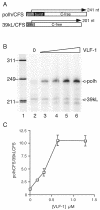Transcriptional activity of baculovirus very late factor 1
- PMID: 15650223
- PMCID: PMC544136
- DOI: 10.1128/JVI.79.3.1958-1960.2005
Transcriptional activity of baculovirus very late factor 1
Abstract
The product of the vlf-1 (very late factor 1) gene is required for expression of very late genes during the final phase of infection. To determine whether VLF-1 functions as a transcriptional activator, VLF-1 was overexpressed and purified by affinity and cation exchange chromatography. The addition of purified protein to transcription assays containing baculovirus RNA polymerase stimulated transcription of the very late polyhedrin promoter but not the late 39k promoter. Furthermore, construction and analysis of chimeric templates identified sequences within the polyhedrin promoter that were necessary for enhancement.
Figures



Similar articles
-
Control of baculovirus polyhedrin gene expression by very late factor 1.Virology. 1998 Aug 15;248(1):131-8. doi: 10.1006/viro.1998.9272. Virology. 1998. PMID: 9705262
-
Identification of baculoviral factors required for the activation of enhancer-like polyhedrin upstream (pu) sequence.Virus Res. 2008 Dec;138(1-2):7-16. doi: 10.1016/j.virusres.2008.07.026. Epub 2008 Sep 11. Virus Res. 2008. PMID: 18760315
-
Bombyx mori nucleopolyhedrovirus ORF34 is required for efficient transcription of late and very late genes.Virology. 2009 Sep 30;392(2):230-7. doi: 10.1016/j.virol.2009.07.003. Epub 2009 Aug 3. Virology. 2009. PMID: 19651423
-
An in vitro transcription system for studying vaccinia virus late genes.Methods Mol Biol. 2004;269:143-50. doi: 10.1385/1-59259-789-0:143. Methods Mol Biol. 2004. PMID: 15114014 Review.
-
An in vitro transcription system for studying vaccinia virus early genes.Methods Mol Biol. 2004;269:135-42. doi: 10.1385/1-59259-789-0:135. Methods Mol Biol. 2004. PMID: 15114013 Review.
Cited by
-
The baculoviruses occlusion-derived virus: virion structure and function.Adv Virus Res. 2007;69:99-165. doi: 10.1016/S0065-3527(06)69003-9. Adv Virus Res. 2007. PMID: 17222693 Free PMC article. Review.
-
In silico identification of putative promoter motifs of White Spot Syndrome Virus.BMC Bioinformatics. 2006 Jun 19;7:309. doi: 10.1186/1471-2105-7-309. BMC Bioinformatics. 2006. PMID: 16784526 Free PMC article.
-
Comparison of CRISPR-Cas9 Tools for Transcriptional Repression and Gene Disruption in the BEVS.Viruses. 2021 Sep 24;13(10):1925. doi: 10.3390/v13101925. Viruses. 2021. PMID: 34696355 Free PMC article.
-
Autographa californica multiple nucleopolyhedrovirus 38K is a novel nucleocapsid protein that interacts with VP1054, VP39, VP80, and itself.J Virol. 2008 Dec;82(24):12356-64. doi: 10.1128/JVI.00948-08. Epub 2008 Oct 15. J Virol. 2008. PMID: 18922869 Free PMC article.
-
Actin Contributes to the Hyperexpression of Baculovirus Polyhedrin (polh) and p10 as a Component of Transcription Initiation Complex (TIC).Viruses. 2022 Jan 14;14(1):153. doi: 10.3390/v14010153. Viruses. 2022. PMID: 35062357 Free PMC article.
References
Publication types
MeSH terms
Substances
LinkOut - more resources
Full Text Sources
Other Literature Sources

